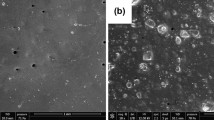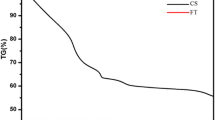Abstract
In this work, a model paint containing several types of inorganic pigments was pyrolyzed in a microwave-heated unit. The goal of the pyrolysis process was to recover and recycle the inorganic components in the paint, most importantly titanium dioxide (TiO2). The solid residue remaining after pyrolysis was further heat treated in air to remove most of the char in the TiO2-containing product. The recovered TiO2-containing product was used in two types of paint formulation as a replacement for virgin pigments. The properties of the paints containing recycled TiO2 pigment and extenders were evaluated and compared with a standard paint formulation containing only virgin TiO2 pigment and virgin extenders. A reduction in paint whiteness was observed but the opacity, gloss, and durability were nearly equivalent to that of the standard paint. Another consequence of using recycled pigments was that the recycled mix of TiO2 pigments and extenders was harder to disperse in the paint than the mix based on virgin materials, thus giving the painted surface a somewhat rough texture. The recycled material has shown promising results as a pigment/extender but further work is needed to optimize the recycled product to meet whiteness and dispersion requirements for incorporation in paint formulations on an industrial scale.








Similar content being viewed by others
References
USG Survey, Mineral Commodity Summaries 2012. U.S. Geological Survey, Reston, 2012
Imam, MA, Froes, FH, Housley, KL, “Titanium and Titanium Alloys.” In: Kirk-Othmer Encyclopedia of Chemical Technology. Wiley, New York, 2000
TZMI, Introduction to the Titanium and Zirconium Value Chains, 2013
Patton, TC, Lewis, PA, Pigment Handbook. Vol. 1: Properties and Economics. Wiley, New York, 1988
Fisher, J, Egerton, TA, “Titanium Compounds, Inorganic.” In: Kirk-Othmer Encyclopedia of Chemical Technology. Wiley, New York, 2000
Jiannis, S, Kougoulis, RK, Walsh, B, Revision of EU European Ecolabel for Indoor and Outdoor Paints and Varnishes, 2012
RebornPaints, 2014. http://www.rebornpaints.co.uk/. Accessed 5 May 2014
CommunitePaints, 2014 http://www.communityrepaint.org.uk/. Accessed 5 May 2014
SAKAB. Om farligt avfall, 2014. http://www.sakab.se/sites/default/files/attachment/vitbok_om-farligt_avfall.pdf. Accessed 3 June 2014
Wang, Y, Namioka, T, Yoshikawa, K, “Research on Gasification and Power Generation from Waste Paint Dregs.” J. Environ. Eng., 3 (1) 182–191 (2008)
Muniz, LAR, et al., “A Study of Paint Sludge Deactivation by Pyrolysis Reactions.” Braz. J. Chem. Eng., 20 63–68 (2003)
Saft, R, “Life Cycle Assessment of a Pyrolysis/Gasification Plant for Hazardous Paint Waste.” Int. J. Life Cycle Assess., 12 (4) 230–238 (2007)
Tukker, A, “Life Cycle Assessments for Waste, Part III: The Case of Paint Packaging Separation and General Conclusions: Strategic EIA for the Dutch National Hazardous Waste Management Plan 1997–2007.” Int. J. Life Cycle Assess., 5 (2) 105–112 (2000)
Nakouzi, S, et al., “A Novel Approach to Paint Sludge Recycling: Reclaiming of Paint Sludge Components as Ceramic Composites and Their Applications in Reinforcement of Metals and Polymers.” J. Mater. Res., 13 (1) 53–60 (1998)
JCPDS-ICCD:PDF-4, Joint Committee of Powder Diffraction Standards, 2013.
Wesołowski, M, “Thermal Decomposition of Talc: A Review.” Thermochim. Acta, 78 (1–3) 395–421 (1984)
Urwin, D, “Surface Area and Porosity of Titanium Dioxide Pigments.” J. Oil Colour Chem. Assoc., 52 (8) 697–710 (1969)
Andersson, M, et al., “Microwave Assisted Pyrolysis of Residual Fractions of Waste Electrical and Electronics Equipment.” Miner. Eng., 29 105–111 (2012)
Samtani, M, Dollimore, D, Alexander, KS, “Comparison of Dolomite Decomposition Kinetics with Related Carbonates and the Effect of Procedural Variables on Its Kinetic Parameters.” Thermochim. Acta, 392–393 135–145 (2002)
Gunasekaran, S, Anbalagan, G, “Thermal Decomposition of Natural Dolomite.” Bull. Mater. Sci., 30 (4) 339–344 (2007)
Clark, RJH, Bradley, DC, Thornton P, The Chemistry of Titanium. Pergamon Texts in Inorganic Chemistry, 99-0125710-7; 19. Pergamon Press, Oxford, 1973.
Burfield, DR, “Compositional Analysis of Waterborne Paint Systems by Thermogravimetry.” Thermochim. Acta, 106C 79–91 (1986)
Day, RE, “The Characterisation of the Surface of Titanium Dioxide Pigments.” Prog. Org. Coat., 2 (4) 269–288 (1974)
Brindley, GW, Nakahira, M, “The Kaolinite-Mullite Reaction Series: II, Metakaolin.” J. Am. Ceram. Soc., 42 (7) 314–318 (1959)
Brindley, GW, Nakahira, M, “The Kaolinite-Mullite Reaction Series: III, The High-Temperature Phases.” J. Am. Ceram. Soc., 42 (7) 319–324 (1959)
Ptáček, P, et al., “Isothermal Kinetic Analysis of the Thermal Decomposition of Kaolinite: The Thermogravimetric Study.” Thermochim. Acta, 501 (1–2) 24–29 (2010)
Guggenheim, S, Chang, YH, Koster Van Groos, AF, “Muscovite Dehydroxylation: High-Temperature Studies.” Am. Mineral., 72 (5–6) 537–550 (1987)
Mazzucato, E, Artioli, G, Gualtieri, A, “High Temperature Dehydroxylation of Muscovite-2M1: A Kinetic Study by In Situ XRPD.” Phys. Chem. Miner., 26 (5) 375–381 (1999)
ISO 6504-3:2006, Paints and Varnishes—Determination of Hiding Power—Part 3: Determination of Contrast Ratio of Light-Coloured Paints at a Fixed Spreading Rate, 2009
ASTM E313, Standard Practice for Calculating Yellowness and Whiteness Indices from Instrumentally Measured Color Coordinates. American Society for Testing and Materials, West Conshohocken, PA, 2005.
ISO 2813:1994, Paints and Varnishes—Determination of Specular Gloss of Non-metallic Paint Films at 20 Degrees, 60 Degrees and 85 Degrees, 1994.
ISO 11998:2006, Paints and Varnishes—Determination of Wet-Scrub Resistance and Cleanability of Coatings, 2006
ISO/CIE 11664-6:2014 (CIE S 014-6/E:2013), Colorimetry—Part 6: CIEDE2000 Colour-Difference Formula, 2014.
Acknowledgments
This work has been funded by Vinnova, Akzo Decorative Paints UK, and Stena Metal AB Sweden, and this is gratefully acknowledged. Dr. Stellan Holgersson, Chalmers University of Technology; Dr. Christopher Knee, Chalmers University of Technology; and Kim Henriksson, Stena Recycling International AB are all acknowledged for their assistance. The authors are also grateful to Dr. Phil Taylor at the Akzo Decorative Paint Slough facility lab for help with formulation and production of the test paints.
Author information
Authors and Affiliations
Corresponding author
Rights and permissions
About this article
Cite this article
Karlsson, M.C.F., Corr, D., Forsgren, C. et al. Recovery of titanium dioxide and other pigments from waste paint by pyrolysis. J Coat Technol Res 12, 1111–1122 (2015). https://doi.org/10.1007/s11998-015-9707-y
Published:
Issue Date:
DOI: https://doi.org/10.1007/s11998-015-9707-y




